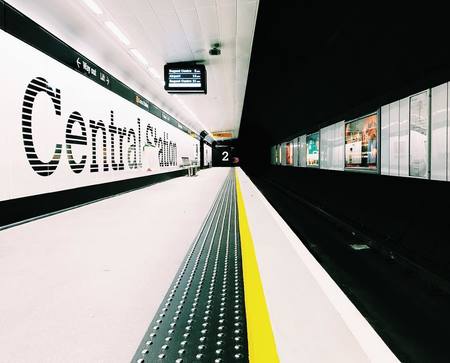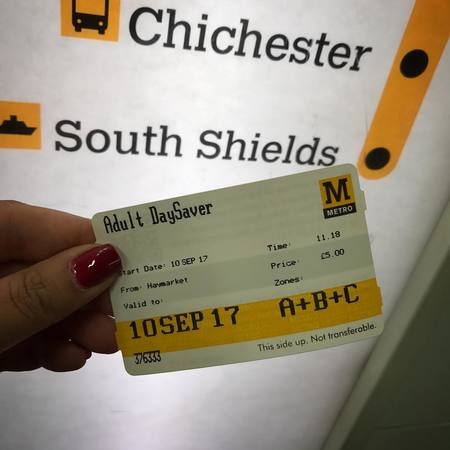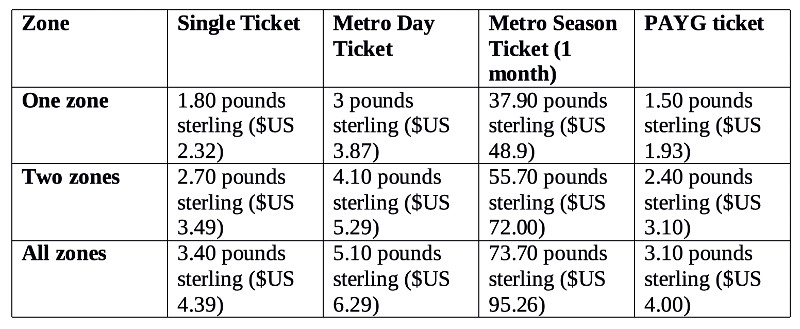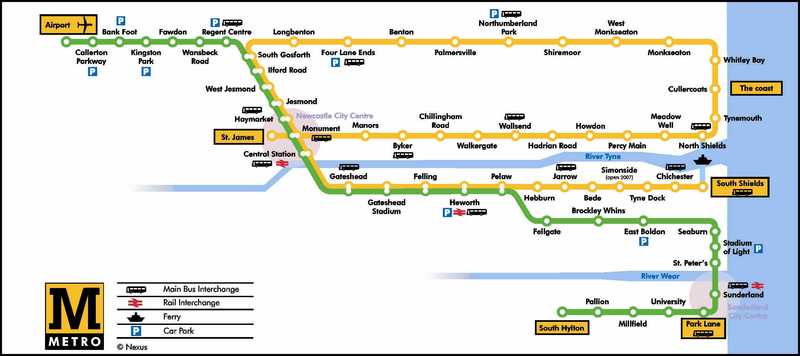The Newcastle upon Tyne Metro, or Tyne and Wear Metro is a rapid transportation system in northeastern England in the United Kingdom. It provides service to the city of Newcastle upon Tyne and consists of an integration between the subway train and light rail.
Currently, there are two operating lines with a total of 60 stations. The total length is 77.5 kilometers (48.2 miles), making it the second largest metro in the United Kingdom, after the London Underground.
It opened on August 11, 1980, when former railway lines were adapted to the subway’s new underground tunnel structure.
The most basic ticket costs 1.80 pounds sterling ($US 2.32) and the operating schedule runs from 5:00 a.m. to 12:00 a.m.
Metros in the United Kingdom: Newcastle upon Tyne
Newcastle upon Tyne is a city in northeastern England, which is part of the United Kingdom of Great Britain and Northern Ireland. The city is part of the Tyne and Wear metropolitan district.
This metropolis is part of the Eurocities network. Founded in 1986, this group connects Europe’s major cities and makes up a total surface area of 113 square kilometers (43.6 square miles). 1,650,000 people live within the network’s total metropolitan area.
The origin of Newcastle dates back to the Roman period, when the Pons Aelius Bridge was elevated to guard the River Tyne. The city provides a comfortable contrast between its traditional structures and modern buildings. Far from harming the view, they complement one another.
Among Newcastle’s most important structures are the Newcastle St James’ Park soccer stadium and Newcastle University, which has one of the most impressive campuses in Europe.
The climate remains rainy, even during the summer. The temperature is about 18 ºC to 19 ºC (64.4 ºF and 66.2 ºF) during the warm months and between 4 ºC and 5 ºC (39.2 ºF and 41 ºF) in the winter.
The Metro
The Newcastle Metro route extends 77.5 kilometers (48.1 miles) around Newcastle upon Tyne, Gateshead, South Tyneside South, North Tyneside North and Sunderland.

The metro began operating on August 11, 1980 with the first section of the green line was put in place.
There are a fleet of 90 vehicles, referred to as “Metrocars”. They have the capacity to carry 84 seated and 188 standing passengers. The latest vehicle renovation was completed in 2015 by the North American company, Wabtech Railen.
This transportation system is managed by the region’s transportation authority, Nexus, which is part of NECA (North East Combined Authority). The metro transports 37.7 million people annually.
- Known as: Metro or Tyne and Wear Metro
- Length: 77.5 kilometers (48.1 miles)
- Rail width: 1435 mm (4.71 ft)
- Number of lines: 2
- Number of stations: 60
- Maximum speed: 70 km/h (43.5 m/h)
- Website: www.nexus.org.uk/metro
- Operator: Nexus
- Daily ridership: 101,300 approximately
- Founded: August 11, 1980
Brief history
The Newcastle railway history began during the early decades of the nineteenth century. The installation of a large number of railway lines grew in direct relation to the increased use of steam as an energy source for a number of things, that included transportation as.
By 1904, the North Eastern Railway (NER), began to electrify the railway network, marking the beginning of an electric railway that would cover all the regions north of the River Tyne.
However, passenger ridership on the electric train was considerably small by 1960 and maintaining the operation based on electric energy was too expensive. Consequently, the railway vehicles were adapted to run on diesel.
It would not be until the 70s, when the local transportation authority began a project to develop and improve the transportation conditions. The decision was to electrify the train rails again and build new subway like rails and tunnels. Work began in 1974 and by August 11, 1980, the first phase of the renovated transportation system was in place.
Lines and stations
The Newcastle upon Tyne Metro is made up of two lines with a total of 60 stations.
The first line opened as a metro line in 1980 and the second one began operating four years later.
Both sections make up a 77.5-kilometer (48.2-mile) route that circulates over most of the city and its surroundings.
Green Line
The Green Line has a total of 31 stations that cover the city’s east-west corridor. The route forms a diagonally curved line.
The terminal stations are the Newcastle Airport stop and Sunderland station and as its name suggests, its distinguishing color is green.
Yellow Line
This route covers the city’s east-west corridor, forming a horizonal shaped line with curved ends. There are 41 stations, 11 of which are shared with the Green Line.
 Newcastle Central Station
Newcastle Central Station
Saint James and South Shields stations are the terminal stops. Yellow is this line’s distinguishing color.
Connections to other systems
Newcastle has several transportation systems that complement the metro. Nexus manages them as well. Their characteristics have been adapted according to the cities they must cover.
Primarily, there is the Shields Ferry. This is an effective transportation method for navigating the River Tyne. It may also be used to travel to the other side of the canal, which is a trip that takes just 7 minutes. The Shield Ferry has four boats, which 400,000 passengers use annually.
In addition to the ferry, Nexus has a bus system in place that serves a major part of the city. There is a total of 17 stations and the three that connect directly to the metro are Four Lane Ends, Heworth and Regent Center. This transportation mode also covers the city’s surrounding areas and serves 30 million passengers annually.
The suburban railway is also run by Nexus. It connects Newcastle upon Tyne to other cities in the United Kingdom, including routes to Edinburg and Glasgow, Leeds and Manchester, Sheffield, Birmingham and London.
Connections to the airport
The Newcastle International Airport is one of the most important air terminals in the United Kingdom. Over 20 airlines operate from here, allowing the city to stay connected to almost every European nation as well as other countries. The airport is located in Woolsington, a village on the outskirts of Newcastle upon Tyne.
The Newcastle International Airport can be reached from the airport terminal station available on the metro’s Green Line. The station is northwest of the city and just a few feet south of the airplane terminal. It is connected through a covered tunnel.
This stop has been operating since 1991 and is considered one of the most efficient within the country’s metro systems. The operating schedule is from 5:37 a.m. to 11:39 p.m. and travel time from the airport to the city center takes just 24 minutes.
Schedule and frequency
The Newcastle upon Tyne metro has a high daily influx of passengers. This led the administrator, Nexus to devise an operational and frequency schedule that would provide service at almost any time of day.
This incorporates two other systems run by the state subsidiary. The schedule and frequency of each line is outlined below:
Green Line
The first train departs from the Airport station at 5:40 a.m. and the last train arrives at Sunderland station at 12:01 a.m.
The weekday and Saturday schedule are the same.
However, on Sundays and holidays, the first train departs at 6:20 a.m. and the last train reaches the terminal station at 11:46 p.m.
The regular train frequency is every 10 minutes. It is every seven to eight minutes during peak hours and every 15 minutes on weekends and holidays.
Yellow Line
The first train departs from St. James station at 6:13 a.m. The last train reaches Gateshead and Barrow station at 11:39 p.m.
The Saturday schedule is the same. On Sundays and holidays, trains operate from 7:00 a.m. to 11:40 p.m.
Like the Green Line, regular train arrival is every 10 minutes. During peak hours, it is every seven to eight minutes and trains arrive every 15 minutes on weekends and holidays.
 Haymarket Metro station
Haymarket Metro station
Fares, tickets and cards
Nexus, Newcastle upon Tyne’s operator, has designed an entire fare system capable of meeting the various demands of its riders.
The price varies according to ticket type, the zones traveled and the rider’s characteristics.
The following list details payment for ticket types and how to obtain them:
- Single ticket: This ticket is valid for any Nexus-operated transportation method. The cost varies according to the zones traveled.
- PAYG card: This acronym stands for Pop Pay As You Go. Riders may purchase their trips as they make them.
- Metro Day Ticket: This ticket offers unlimited trips on any of Nexus’ modes of transportation with variations according to the zones traveled.
- Metro Season Ticket: This ticket includes several trips and is ideal for frequent travelers.
- Student Metro Ticket: Student tickets receive a 30% discount and are available to all students who present a student ID at Nexus ticket windows.
It should be noted that children under the age of 5 ride free of charge. Children between the ages of 5 and 16 may use the Pop Friendly card, which offers unlimited trips in one zone for 1.10 pounds sterling ($US 1.42) or a single trip may be taken for 0.60 pound sterling ($US 0.77).
 NewCastle Metro Fares
NewCastle Metro Fares
System Regulations
Regulations are always needed in systems that transport a large number of riders. These rules are employed to maintain public order, rider civility, proper care of facilities and people’s physical and moral integrity. Below are some of the regulations outlined by Nexus:
- Eating and drinking are not permitted in system facilities.
- The only animals permitted in the system are guide animals assisting disabled passengers.
- The use of firearms or weapons such as knives is not permitted.
- Bicycles are not permitted in any train cars or on any other Nexus’ modes of transportations.
- System trips must correspond to the acquired ticket type.
- Children, under the age of 12, may not travel in the system without supervision.
- All system users must follow the instructions of metro personnel.
- Shouting and violent behavior is prohibited in any system facility.
- Any damage to Nexus metro transportation facilities is prohibited.
- Selling goods and panhandling are not permitted in any system facility.
Future expansions
Nexus has been considering a series of expansions on the system’s current lines since 2004. The goal is to increase ridership, provide faster service and improve efficiency.
Primarily, there is the construction of a route between Tyne Dock and East Boldon, which will connect the two currently operating lines. This will form a direct connection in the south of the city, where there is currently no transfer point between the two lines.
Another proposal is the construction of a line extending from Leamside to Washington. It has been approved by the regional government. However, Nexus has yet to launch the construction of this new section.
One of the most compelling projects is a connection to the Blyth and Ashington Metro system, that will be completed through the Northumberland Park station.
Additional plans include the expansion of the Green and Yellow Lines respectively. The first includes a new section heading north while the second will extend to the far west. However, both are delayed due to the high costs of constructing new tunnels and railway extensions.
Tips
- The Newcastle upon Tyne Metro is among Europe’s safest metros. However, riders should always be cautious while in metro facilities. Maintaining constant attention of one’s belongings is recommended, taking care to carry them close, especially in front of the body.
- The system has a large number of fare options. Consulting the metro’s official webpage to select the most suitable ticket is recommended.
- Nexus, the state subsidiary responsible for the city’s transportation, operates two additional transportation methods. As a result, it is extremely important to determine which routes may aid one’s trip throughout the city. There are zones with no subway access.
- The metro operator, Nexus has a travel planning system in which stations can be selected and its train arrivals will be displayed. This app is instrumental in reducing wait time on the platforms and expediting riders’ movement throughout the system.
- It is also essential that all riders familiarize themselves with system regulations to avoid any fines from Nexus authorized personnel.
- Finally, although this subway system is not particularly large or complex, it is always wise to consult a system map. This will help riders to familiarize themselves with distances, which could often be too long for some.
Interesting facts
- The Newcastle upon Tyne Metro was the first railway system in the United Kingdom to demonstrate all its characteristics, including its speed in distance, using the metric system.
- This transportation system is characterized by an important exponent of the city’s fine arts. Some of its stations have been transformed into grand scale works of art featuring the city’s culture within the medium of the railway. Most works were especially commissioned to represent important artistic exponents along various latitudes. Among some of the most famous standouts are the “Nocturne” by Nayan Kulkarni and Hadrian’s Wall Map by Michael Pinski.
- This system was originally designed to work together with the ferry and bus lines, under a completely unified mechanism while having the same standard fare. However, this goal was not met and transfer tickets were produced instead to allow travel from one transportation mode to another.
Sightseeing via the Newcastle upon Tyne Metro
Newcastle upon Tyne is one of the United Kingdom’s most significant cities. Over the years, it has transformed into a popular tourist destination for the many people visiting the United Kingdom. Its Roman and medieval past make the city a living part of history, yet it has also come to represent modernity and athleticism. The metro is one of the best ways to get around the city. Included below are some of the sites that can be reached via the Newcastle upon Tyne Metro:
Chinatown: Like most of the world’s cities, the Newcastle upon Tyne’s Chinatown is a major attraction to anyone touring the city. This is due to its many commercial activities and the cultural effervescence that centers around its streets. Most tourists stop along these streets to obtain traditional Asian spices and to savor new culinary experiences. To reach this destination, one must simply get off at St James station on the metro’s Yellow Line and walk a few meters.
Hatton Gallery: Hatton Gallery is one of the city’s most important sites for artistic expression. This is the University of Newcastle’s gallery located in the University’s Fine Arts Building. This facility was founded in 1925 by the King Edward VII School of Art. The Hatton Gallery has a permanent exhibition of over 3500 works, that date back to the sixteenth century. Among the exhibitions there are paintings, recordings and sculptures. Some are grand scale. If wishing to visit, one must simply get off at Haymarket station on the Yellow Line and walk a few blocks.
Grey’s Monument: This is one of the most visited monuments in the city. This statue was erected in Lord Grey’s honor for his approval of the Great Reform Act of 1832. It is 40 meters (131.2 feet) high and was designed by the architects John and Benjamin Green. The historical value of this monument is immense, not only due to its construction but also due to the lightning bolt that destroyed Lord Grey’s head in 1941. To visit this statue, one must simply get off at Monument station, found on the Yellow and Green Lines and take a short walk through the city’s historic center.
Newcastle metro map
- Passengers/Day 104000
- Fares:
- 24h operation: No
- Air Conditioning: No
- Walk between platforms: No
- Driverless trains: No
- Screen Doors Platforms: No
- £2.80
- Newcastle Metro Official Website
Help us
If you consider that the information we provide is wrong, not accurated, outdated, translation contains errors, and you would like to help us to improve the file...you can contact us here.
Feel free to contact us if you dont find the system you're looking for and we'll add it as soon as we can!
Thank you very much!







